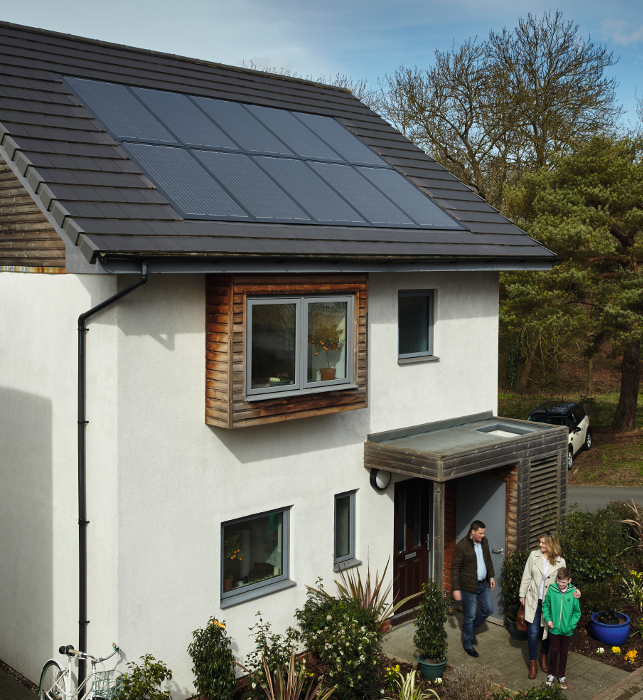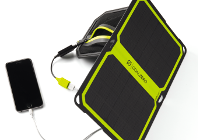
The Nomad 7 Plus solar panel, which will directly charge most USB and 12V devices directly from the sun, weighs in at just 363g and has a solar capacity of 7W
Taking charge
For those who enjoy adventure in the great outdoors, but don’t want to seek out electricity or carry battery packs to charge cameras and phones, US company Goal Zero has created a solution just for you.
All you need is sunshine and the Nomad 7 Plus portable solar panel. In fact, the system is a redesign of a previous product but weighs less and does more.
Essentially, you open up the solar panel, plug in your device with the USB cable and then use the detachable kickstand for optimum angle placement to get the most rays. An LED indicator will then blink to let you know how fast your device is charging.
Four lights means there are more than five watts available. Also, with the auto restart feature, if the device being charged disconnects due to environmental causes (lack of sunlight, shadow etc.), the Nomad 7 Plus will automatically reconnect it.
According to Hank Howell, Goal Zero industrial designer, the Nomad 7 Plus was challenging mostly because a solar panel is a flat 2D design project.
“There are so many solar panels out there now so it was difficult to find a way to make it really jump forward and be innovative.”
One way the design team found of doing this is that instead of the traditional technique of sewing and stitching, they used a lamination process.
“With this process we could make the panel super flat and thin which takes a lot of the weight out while also improving the durability, water resistance and temperature regulation,” adds Howell.
The main feature of the design is the leg that acts as a kickstand. It not only holds the panel up at the right angle without having to find something to lean it against, but also provides natural shade and a vented pocket holds devices that are being charged.

The 8W battery powered-system comes with two LED lights, a LED torch and radio that are all charged through the control unit
Let there be light
Many rural areas in Africa may not have electricity but they do have a lot of sunshine. Utilising this energy, Kenya-based M-Kopa has created the M-Kopa IV Solar Home System.
M-Kopa approached UK design consultancy Greaves Best Design (GBD) with the brief of designing products based on its proprietary, patented technology platform, which combines embedded GSM (Global System for Mobile Communications) and mobile payments.
The aim was to create a distinct product identity with key requirements including durability, dust exclusion, tamper-proofing and security.
“Another big aim was to replace kerosene lamps which are widely used in rural areas of Africa with clean energy. Kerosene is inefficient, dangerous and expensive with extensive health and environmental drawbacks,” says Jon Fairley, industrial designer at GBD.
The design team used SolidWorks during the product development process before prototypes were built for validation and tooling and manufacturing carried out with Chinese factories.
As Fairley says, “To have such a design opportunity is fantastic because M-Kopa has now connected more than 330,000 homes in Kenya, Tanzania and Uganda to solar power with 500 new homes being added every day.”

Sunstation is a new building-integrated photovoltaic (BIPV) solar roof system designed by Solarcentury to look good and be price competitive
Catch the sun
Solarcentury is on a mission to make good looking solar accessible to the masses.
Its new Sunstation sits neatly in the roof rather than protruding from it like many traditional on-roof systems.
But aesthetics wasn’t the only goal, it wanted to design a module that could be manufactured using high levels of automation, rather than being assembled by hand.
“No more hand-assembly means drastic reductions in manufacturing costs,” explains Ryan Brand, product development engineer at Solarcentury.
An important aspect of the design was that the Sunstation requires no sub-frame and fixes directly to the roofing battens.
“The intuitive nature of Lego was our inspiration for designing the interlocking system that enables each Sunstation module to lock into the one preceding it.”
Testing played a significant role in the development process. Having designed the system in SolidWorks as well as making use of its built-in analysis tools, 3D printed prototypes were put into the hands of installers at a very early stage.
“By putting crude, conceptual prototypes into the hands of actual installers, we were able to fail early and fail fast as a means to refine the product into something that, in its final form, feels inevitable.”
A look at products that are being powered by the sun
Default






